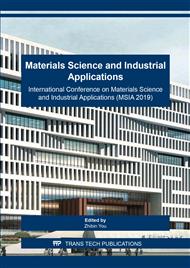[1]
J. Zhang, M. Zhang, W. Tang, W. Wang, and M. Wang, Buckling of spherical shells subjected to external pressure: A comparison of experimental and theoretical data,, Thin-Walled Structures, vol. 111, pp.58-64, 2017/02/01/ (2017).
DOI: 10.1016/j.tws.2016.11.012
Google Scholar
[2]
M. Zhang, W. Tang, F. Wang, J. Zhang, W. Cui, and Y. Chen, Buckling of bi-segment spherical shells under hydrostatic external pressure,, Thin-Walled Structures, vol. 120, pp.1-8, 2017/11/01/ (2017).
DOI: 10.1016/j.tws.2017.08.017
Google Scholar
[3]
E. Fathallah, H. Qi, L. Tong, and M. Helal, Multi-Objective Optimization of Composite Elliptical Submersible Pressure Hull for Minimize the Buoyancy Factor and Maximize Buckling Load Capacity,, Applied Mechanics and Materials, vol. 578, pp.75-82, (2014).
DOI: 10.4028/www.scientific.net/amm.578-579.75
Google Scholar
[4]
Y. Zhu, Q. Ma, J. Zhang, W. Tang, and Y. Dai, Opening reinforcement design and buckling of spherical shell subjected to external pressure,, International Journal of Pressure Vessels and Piping, vol. 158, pp.29-36, 2017/12/01/ (2017).
DOI: 10.1016/j.ijpvp.2017.10.006
Google Scholar
[5]
C. T. F. Ross and A. P. F. Little, The Buckling of a Corrugated Carbon Fibre Cylinder Under External Hydrostatic Pressure,, Ocean Engineering vol. 28, pp.1247-1264, (2001).
DOI: 10.1016/s0029-8018(00)00039-1
Google Scholar
[6]
M. J. Smith, T. Macadam, and J. R. MacKay, Integrated modelling, design and analysis of submarine structures,, Ships and Offshore Structures, vol. 10, pp.349-366, (2015).
DOI: 10.1080/17445302.2014.937058
Google Scholar
[7]
Z. Sekulski, Multi-objective topology and size optimization of high-speed vehicle-passenger catamaran structure by genetic algorithm,, Marine Structures, vol. 23, pp.405-433, (2010).
DOI: 10.1016/j.marstruc.2010.10.001
Google Scholar
[8]
J. R. MacKay, M. J. Smith, F. van Keulen, T. N. Bosman, and N. G. Pegg, Experimental investigation of the strength and stability of submarine pressure hulls with and without artificial corrosion damage,, Marine Structures, vol. 23, pp.339-359, 2010/07/01/ (2010).
DOI: 10.1016/j.marstruc.2010.06.001
Google Scholar
[9]
M. Aydogdu and T. Aksencer, Buckling of cross-ply composite plates with linearly varying In-plane loads,, Composite Structures, vol. 183, pp.221-231, 2018/01/01/ (2018).
DOI: 10.1016/j.compstruct.2017.02.085
Google Scholar
[10]
J. Zhang, M. Wang, W. Wang, W. Tang, and Y. Zhu, Investigation on egg-shaped pressure hulls,, Marine Structures, vol. 52, pp.50-66, 2017/03/01/ (2017).
DOI: 10.1016/j.marstruc.2016.11.005
Google Scholar
[11]
J. Y. Han, H. Y. Jung, J. R. Cho, J. H. Choi, and W. B. Bae, Buckling analysis and test of composite shells under hydrostatic pressure,, Journal of Materials Processing Technology, vol. 201, pp.742-745, 2008/05/26/ (2008).
DOI: 10.1016/j.jmatprotec.2007.11.228
Google Scholar
[12]
J. R. Vinson and R. L, The Behavior Of Structures Composed Of Composite Materials: Springer, Dordrecht, (2008).
Google Scholar
[13]
A. K. Kaw, Mechanics of Composite Materials, Second Edition ed.: CRC Press Taylor & Francis Group, (2006).
Google Scholar
[14]
P. D. Soden, M. J. Hinton, and A. S. Kaddour, A comparison of the predictive capabilities of current failure theories for composite laminates,, Composites Science and Technology, vol. 58, pp.1225-1254, 1998/07/01/ (1998).
DOI: 10.1016/s0266-3538(98)00077-3
Google Scholar
[15]
J. Arora, Introduction to Optimum Design vol. 4th Edition: Elsevier (2016).
Google Scholar


